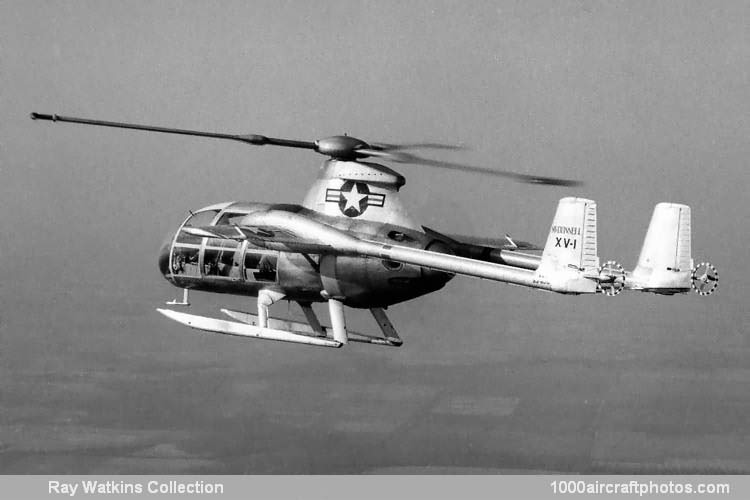01/31/2010. Remarks by Johan Visschedijk: "This experimental convertiplane was a joint development of the Wright Air Development Center, USAF, the Transportation Corps of the US Army and the McDonnell Aircraft Corporation. Designed by Friedrich Doblhoff, Austrian helicopter pioneer who had developed the Wn 342 in Germany during World War II, it used a jet-driven rotor for vertical flight and wings and a normally-driven pusher propeller for forward flight, during which the rotor auto-rotates at its lowest drag configuration.
Each of the three blades of the rotor was powered by a McDonnell pressure-jet unit located at the blade tip. A 550 hp Continental R-975-19 piston engine in the rear fuselage powered two compressors to supply air to the jet units during vertical flight, and powered the 6 ft 5 in (1.96 m) diameter Met-L-Prop two-blade propeller during forward flight. Fuel was fed to the rotor-tip jet burners through a rotary fuel governor which was driven from the rotor hub accessory drive.
The aircraft was initially designated L-25 as a liaison machine but soon changed to H-35 in the Army/USAF helicopter series. After the convertiplane designation (V) was established in 1952 the designation was changed to
XV-1.
The fuselage had a cabin in its forward end with extensive plexi-glass to facilitate three passengers, or two stretcher patients and medical attendant, in addition to the pilot. The enclosed crew compartment was separated from the engine section by a structural firewall. Pilot and copilot/observer sat in tandem and were provided with removable dual controls. Exit doors could be jettisoned in an emergency.
The tail assembly consisted of two vertical fins and rudders attached to the extremities of twin tail booms. A freely-floating horizontal tail surface was mounted between the booms. The landing gear consisted of two non-retracting skids. Landing shocks were absorbed by the yielding of replaceable stainless steel straps.
The first of two prototypes (s/n 53-4016, 53-4017) was completed in early 1954, and tethered hover tests began on 15 February 1954. Problems with the pressure-jet system delayed free flights until that summer. The first successful conversion from helicopter to conventional flight took place on 29 April 1955. After initial tests a small rotor for directional control was installed at the after end of each boom. The XV-1 became the world's first rotary-wing aircraft to reach a speed of 200 mph (322 kmh) on October 10, 1956.
The performance of the XV-1, however, did not justify developing it to operational status, especially in comparison with advanced helicopter designs, and the program was terminated in 1957. 53-4016 is preserved at the US Army Aviation Museum at Fort Rucker, Alabama, while 53-4017 is preserved at the NASM's Paul E. Garber Restoration and Storage Facility, Suitland, Maryland."
